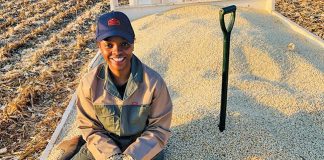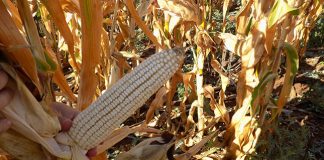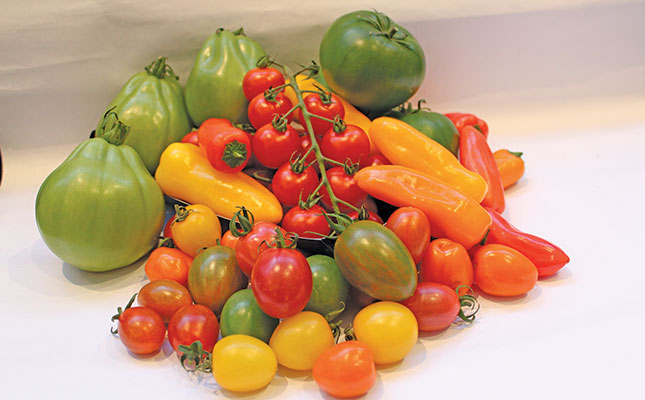He told Annelie Coleman how he advanced from a farm manager to a leading agricultural entrepreneur. Hard work, entrepreneurship and a deep dependence on his faith are the secret to Dolf du Bruyn’s success. This qualified boilermaker grew up in Van Zylsrus in the Kalahari, and today farms on the farm Ons S’n, 30km east of Bultfontein in the Free State. He started his career in agriculture as a farm foreman in Theunissen, followed by a stint as a farm manager in the Bultfontein district.
“I always wanted to farm for myself. Twenty years working for other people gave me the opportunity to gain the necessary practical knowledge and experience,” says Dolf. “My wife Estie and I started from scratch. It took gruelling work, but today I only owe the bank and co-op money. I don’t owe anybody else anything. Hard work, effective planning and strict financial discipline got me there.” As to the key to his success, Dolf says, “Look after your workers.
Treat them humanely and be honest with them. They’re one of your business’s biggest assets. “Keep tight control of every aspect of your business. A farmer must be on the farm, not hanging around town. Lastly, never underestimate the value of organised agriculture. Grain SA has played an immense role over the years in furthering South African grain producers. I’m a proud member of the organisation.”
High-potential water-table soils
Dolf farms on mostly high-potential water-table Avalon soils, 1,5m to 2m deep and suitable for a variety of cash crops, such as maize, sunflower, groundnuts and wheat. Of his 23 centre pivots, six are nine-tower units. Maize, wheat and groundnuts are planted under irrigation. “I spread the risk of grain production by diversifying and rotating crops.
Groundnuts is a particularly valuable crop in a rotation system. It returns nitrogen to the soil, while the hay feeds livestock. Some 10% of the irrigated maize lands are left fallow annually,” says Dolf. “We plan the rotation so that any piece of land is only used for groundnuts once every five years to prevent diseases.” Dolf plants 1 100ha to wheat, 500ha of which is under irrigation. He plants 600ha rainfed and 600ha irrigated maize, as well as 300ha rainfed and 100ha irrigated groundnuts.
Should the optimum planting dates for maize expire, due to adverse weather, he plants sunflower. Dolf depends on Grain SA and other grain cultivation experts for cultivar selection. He plants wheat seed at a rate of 125kg/ha under irrigation and 20kg/kg rainfed. In the case of groundnuts, the density is 50kg/ha on both rainfed and irrigated land. Irrigated maize, at a plant population of up to 40 000 plants/ha, often yields 16,5t/ha, where rainfed maize is planted at a density of at least 20 000 plants/ha.
Bonsmaras and Mutton Merinos
“Livestock adds value to my business,” Dolf explains. “The grain division provides a mountain of stover and hay that enables me to diversify into cattle and sheep.” He runs a commercial herd of Bonsmara-cross cows with Angus bulls. The weaners are backgrounded in the feedlot on the farm on mainly maize and groundnut hay, and sold mostly to the Sparta abattoir in Welkom. Guinea grass (Panicum maximum) pasture established on the marginal land and maize stover complete the fodder resource.
The SA Mutton Merino stud and commercial flocks are Dolf’s pride and joy. The Mutton Merino is a hardy, non-selective grazer that produces maximum meat and wool. He manages theft and predation losses by keeping the lambing commercial ewes and young lambs in 24 lambing camps of 15m x 20m (totalling 0,72ha), and lambing stud ewes and young lambs in 22 lambing camps of 10m x10m, totalling 0,22ha. Ten stud ewes and 17 commercial ewes are kept per lambing camp.
The smaller stud camps allow Dolf to give more individual attention to the ewes and lambs. “They’re put on pasture after about two weeks when the lambs are slightly bigger and stronger. The small camp system allows me to accommodate around 630 lambing ewes. With this system, I can keep 1 400 sheep on 16ha and control losses more effectively.
“The stud and commercial ewes are run on two separate farms. The stud ewes are run on wheat stover, grazing maize and oats. Grazing maize and oats is grown on 14ha irrigated land. The ewes are synchronised and then artificially inseminated with a laparoscope. Ewes that don’t conceive here are put with the rams.”
The SA Mutton Merino is resilient and very well adapted to this system. No supplementary feed is provided except Maxi Wool Licks and groundnut stover in the lambing pens from two weeks before lambing. The sheep feedlot accommodates up to 2 000 sheep at any given time. Dolf beneficiates maize and groundnut hay through the feedlot, selling the sheep to the Theunissen abattoir.
Stock theft worse than ever
But no system is foolproof. The throats of 17 of Dolf’s commercial ewes were cut on the weekend of the Grain SA Grain Producer of the Year gala dinner. On the eve of Farmers Weekly’s visit, 20 commercial ewes with seven lambs were stolen. Early in November, another eight commercial ewes fell prey to stock thieves.
“I believe these thefts are committed by syndicates,” Dolf says. “We aren’t far from Welkom and the live sheep and carcasses can be whisked off to the local townships and squatter camps in an hour or less. “I lost more sheep in October and November than I did in the past 12 years. That’s why I don’t want to give out statistics on my livestock – stock thieves can read too.” Dolf is installing cellphone technology to curb the thefts, and has a team of herdsmen looking after the sheep. But, as he explains, they can’t be everywhere.
A family business
Dolf’s son Theuns is a qualified diesel and petrol mechanic and farms with him. Theuns is responsible for maintaining and repairing nearly all of the equipment and vehicles. An item of equipment is only replaced when maintenance becomes too expensive. Theuns and Dolf recently built a stubble cultivator for R 80 000. The normal price is around R400 000.The Du Bruyns beneficiate some of their maize through chickens.
Estie and her daughter Cecile Cronje’s 3 000 laying hens add value to the business. Cecile is married to a neighbouring farmer and runs the laying business in partnership with her mother. Six hundred point-of-pay High Line hens are ordered from a supplier in Parys every second month, while all the eggs are supplied to a distributor in Welkom.
What about the future?
“I’m content to carry on with my farming enterprise as long as possible with my wife and children. Government must grasp the importance of commercial agriculture and the role farmers play in providing affordable food and food security,” says Dolf. “I’m concerned about the possible negative impact of the land reform process on agriculture as a whole. I hope that government can get land reform on a sound footing to benefit the entire agricultural sector in South Africa.”
Contact Dolf du Bruyn on 082 338 2376.













